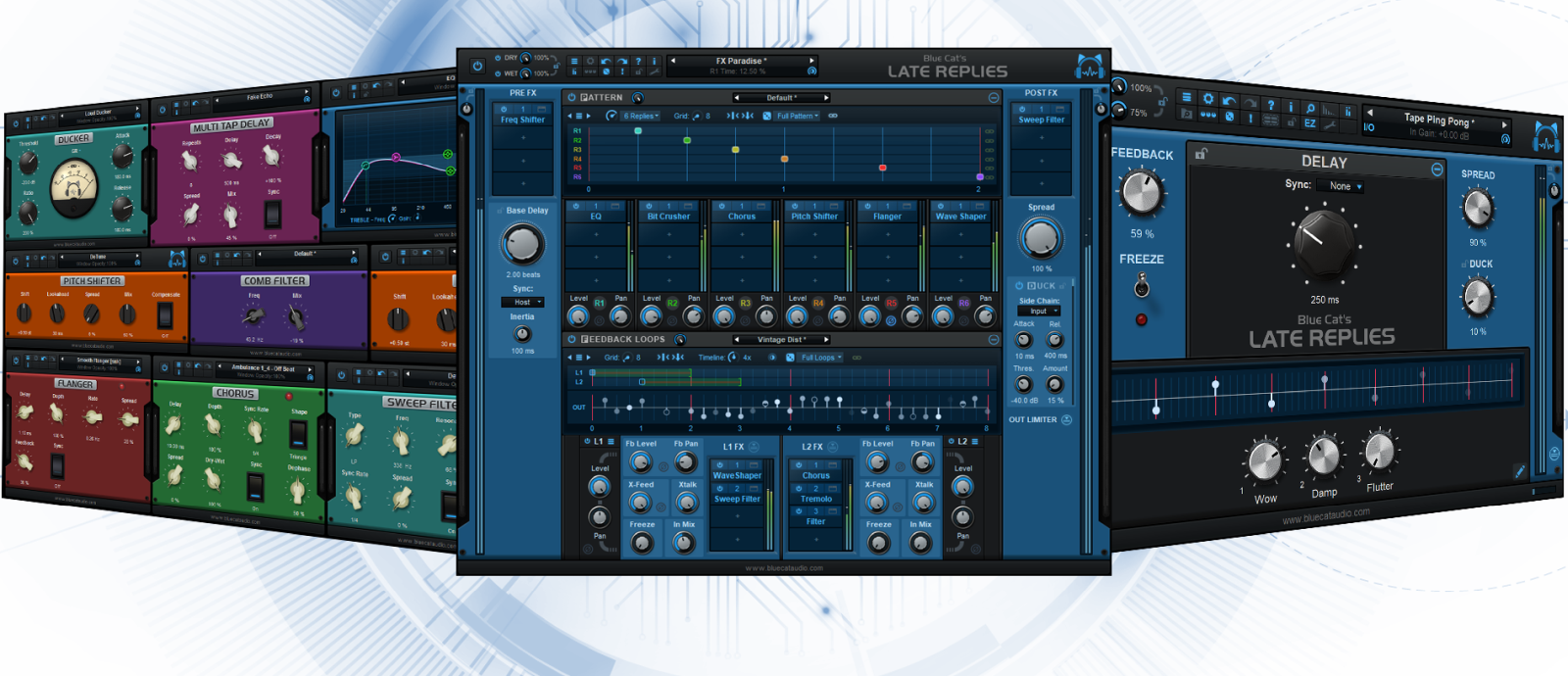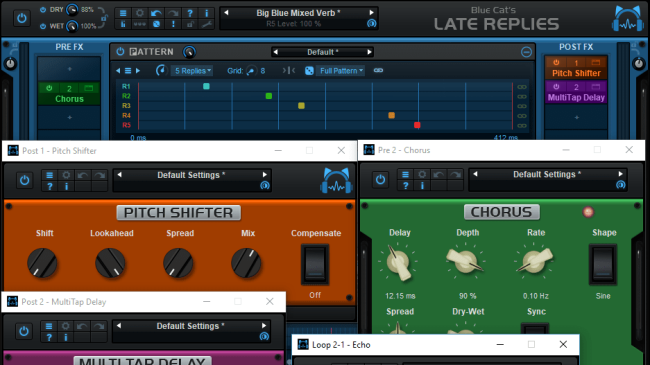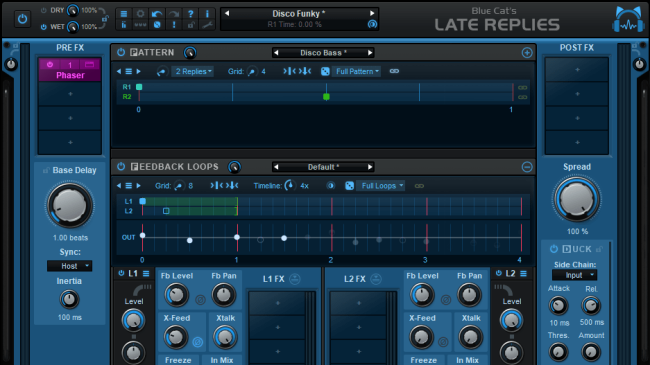Table Of Content
Introduction
Blue Cat's Late Replies is a powerful delay, reverb and multi effects plug-in that can be indefinitely extended by hosting third party VST, VST3 or AU plug-ins anywhere in the signal path.
With its unique topology, the plug-in is a full-featured delay machine with unlimited powers: both the 8 taps pattern module and the two nested feedback loops include plug-in slots that can host built-in effects or third party plug-ins.
So it's not just about delays! The plug-in includes 29 built-in effects to further manipulate the delay lines: modulation effects, EQ and filters, dynamics processors, pitch and frequency shifters, wave shaper...
With the integrated ducker and its side chain input, ducking delays or reverbs has never been so easy.
Blue Cat's Late Replies is delivered with hundreds of presets producing many kinds of audio effects: classic delays, rhythmic or melodic patterns, reverbs, vintage echoes, shimmer effects, sci-fi sounds... Browse and edit them quickly with only a few parameters in "easy mode", or expand the user interface to "full edit" mode to create your own creative delays, reverbs and effects, with complete control over the entire signal chain.
Typical applications: Delays with built-in effects, rhythmic patterns, melodic patterns, third party plug-ins hosting, reverbs, shimmer, drones, creative effects, pitch shifting, modulation effects, looper, tape delays...
Credits: this plug-in includes several factory presets created by Sink and Hans Van Even.
System Requirements
MacOS
- An Intel or Apple Silicon processor.
- Mac OS 10.9 or newer.
- Any VST / Audio Unit / AAX compatible application (64-bit) .
Windows
- An SSE2-enabled processor (Pentium 4 or newer).
- Microsoft Windows Vista, Windows 7, 8, 10 or 11.
- Any VST / AAX compatible host software (32 or 64 bit).
For more information about supported platforms, see our Knowledge Base.
Demo Limitations:
- 5 instances of the plug-in allowed per session.
- The effect is bypassed for half a second every minute.
Installation
The plug-ins versions cannot be run standalone: they require a host application (see the System Requirements chapter for more information). Depending on which host application you use, you might need to install the plug-ins in different locations.
Before installing one of the plug-in versions, you should close all your host applications.
Windows
Install
All versions of the plug-in provide an installation program. Follow the steps of the wizard to install the software on your machine. During the installation you will be asked where you want the software to be installed. For the VST version, you should install the plug-in inside the VST plug-ins folder used by your host application(s). The default path set in the installer should work for most applications, but you should check your host software documentation to know where it looks for VST plug-ins. For other plug-in types, you should just use the standard path.
Some applications will not automatically rescan the new plug-ins, so you might have to force a refresh of the plug-ins list.
Upgrade
When a new version of the software is released, just launch the new installer: it will update the current installation.
Uninstall
To uninstall the software, simply launch the "Uninstall" program that is available in the start menu or in the configuration panel. It will take care of removing all files from your computer.
Mac
Install
On Mac the plug-ins are available as drive images with an installer. After download, double click on the dmg file to open it. You can then double click on the installer (.pkg file) to install the package.
Note for Mac OS 10.15 Catalina or newer: you may have to right click on the installer and select "Open" instead of double clicking on the file to launch the installation if your computer is not connected to the Internet.
Upgrade
When a new version of the software is released, just launch the new installer: it will update the current installation.
Uninstall
To uninstall the software, simply remove the component(s) from their install location (move them to the trash):
- AAX plug-ins are installed in the /Library/Application Support/Avid/Audio/Plug-Ins/ folder
- Audio Units (AU) are installed in the /Library/Audio/Plug-Ins/Components/ folder
- RTAS Plug-ins are installed in the /Library/Application Support/Digidesign/Plug-Ins/ folder
- VST plug-ins are installed in the /Library/Audio/Plug-Ins/VST folder
- VST3 plug-ins are installed in the /Library/Audio/Plug-Ins/VST3 folder
If you want to completely remove all settings and configuration files, you can also remove these additional directories that may have been created on your computer:
- ~/Library/Preferences/Blue Cat Audio/[Plug-in name and TYPE], where TYPE is VST, AU, RTAS or AAX: global preferences.
- ~/Library/Preferences/Blue Cat Audio/[Plug-in name]: license information
- ~/Documents/Blue Cat Audio/[Plug-in name]: user data, such as presets, additional skins and user-created plug-in data.
Please be aware that these directories may contain user data that you have created. Remove these directories only if you do not want to reuse this data later.
First Launch
Blue Cat Audio plug-ins cannot be run standalone, they require a host application (see the System Requirements chapter for more information). Some host applications will require you to scan the plug-ins before they are available in the application.
If the plug-in is not available in the application, please check that it has been installed in the appropriate directory (with no host application running), and that the host application has scanned it.
Using Blue Cat's Late Replies
Introduction
Overview
Blue Cat's Late Replies is a delay plug-in with a couple of twists. It has been designed to offer a flexible experience to create audio effects based on delays. It lets you insert third party plug-ins as well as built-in effects in many locations in the signal path.
It is composed of two main modules in series: the "Pattern" module, a multitap delay including effects for each individual echo, and the "Loops" module, two parallel feedback loops that can also be fed back into each other. Each feedback loop also has the ability to host built-in or third party plug-ins, so that each new echo gets more effects than the previous one.
Signal Path
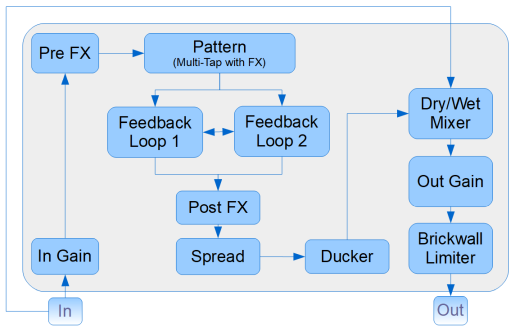
The wet signal goes thru the following path:
- Input gain: adjust the gain of the incoming signal to be processed by the plug-in (does NOT affect the dry signal).
- Pre FX section: apply effects or third party plug-ins before reaching the delay lines.
- Pattern section: multi tap delay with embedded mixer. You can apply audio effects to individual taps.
- Loops section: two parallel feedback loops that can interact with each other (cross feedback). Effects can be applied to the feedback path.
- Post FX section: apply effects or third party plug-ins after the delays.
- Spread control: manage the amount of "stereoness" of the wet signal.
- Ducker: the wet signal can be ducked by the input or the external side chain.
Both the dry (unprocessed input) and wet signals are then mixed together (using the dry/wet controls), before reaching the output stage:
- Output gain: adjust the gain of the mixed dry/wet signal.
- Output limiter: protects the output of the plug-in (delays may generate lots of feedback and high gain signals).
Built-In Effects
Blue Cat's Late Replies includes 30 top quality built-in effects that can be used in plug-in slots, next to third party VST, VST3 or AU plug-ins:
Bit Crusher, Chorus, Comb Filters, Compressor, Ducker, Echo, Multitap Delay, EQ, Multimode Filter, Flanger, Frequency Shifter, Gain, Gate, Stereo Pan, Phase Shifter, Phaser, Pitch Shifter, Stereo Strip, Sweep Filter, Tremolo, Waveshaper, Micro EQ, MS Encoder & Decoder...
Late Replies is also available as a built-in plug-in, so that you can load it into itself and share the presets.
Built-in plug-ins offer the same preset management and control features as the main plug-in (MIDI learn, undo/redo, parameters range...). For more details about each effect and its controls, please refer to the included documentation ("?" icon in the toolbar of each plug-in).
Custom Delays
Thanks to this powerful and open architecture, it is possible to create your own custom delays with effects. There are also hundreds of predefined presets (pitch shifting delay, tape delay, analog delay etc.) that you can use as if they were different delay plug-ins. Just open the plug-in in EZ mode and browse the presets!
With the macro parameters, you can also define your simple controls to tweak the effect, wihtout having to open the plug-ins loaded inside Late Replies. Again, check out the presets in "EZ" mode to see these macro parameters in action.
MIDI Preset Loading
It is possible to load presets using MIDI (with Bank Select and Program Change messages). More details about MIDI and presets loading is available in the presets section.
Multicore Processing
Late Replies includes a multicore processing engine that can spread replies (delay taps) processing on separate processor cores, in the pattern module. It lets you use all your processor cores at the same time and load more effects at the same time.
Note: effects that are processed in series (one after the other) cannot be parallelized and do not benefit from multicore processing. Only independent taps of the pattern section can be processed independently. Feedback loops will not benefit from this setting.
The multicore engine can be activated or deactivated for each preset independently. When using very few plug-ins with low CPU usage in parallel, the cost of multicore processing can be higher than the benefits (you can check the CPU usage with the built-in CPU meter at the bottom right of the user interface).
Performance also depends on the host application and its own multicore processing strategy, so you may want to try and compare with or without multicode enabled.
The User Interface
Note: The main toolbar, menus and basic features available with all our plug-ins are detailed in the Blue Cat Audio Plug-ins Basics section.
Overview
The user interface in full edit mode mostly follows the signal flow described in the previous chapter from top to bottom and from left to right:
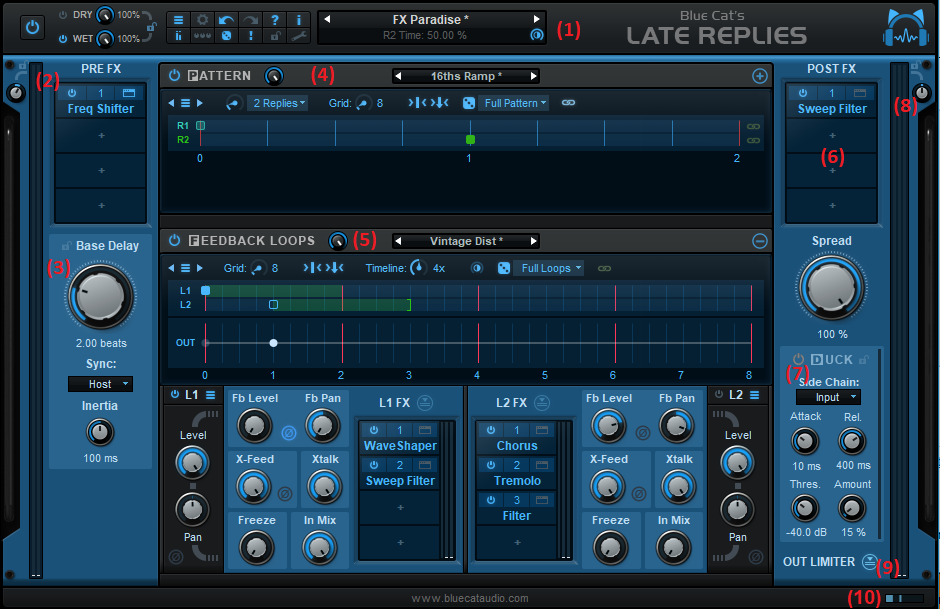
Main Components
- The main toolbar, with from left to right: the bypass button, dry and wet mix controls, the main toolbar buttons, the presets manager and text display LCD.
- The input and Pre-FX controls and input level meter.
- The Base delay settings.
- The pattern module, a multitap delay with embedded effects.
- The feedback loops module, containing two parallel feedback delays with effects and cross-feedback interaction.
- The post effects and spread controls.
- The ducking module, to duck the wet signal based on main or side chain input.
- The out gain control and output level and limiting meter.
- The brickwall limiter switch, to enable or disable the limiter. You will usually want to keep it enabled to protect the output of the plug-in. in this case you should try to adjust the output gain so that the limiter is not triggered, unless you explicitly want its pumping effect.
- Real time workload meter that measures CPU load.
Meters
The reverse blue meter next to the output level meter displays the gain reduction performed by the output brickwall limiter.
Workload Meter
The workload meter on the bottom right of the user interface gives an idea of the amount of cpu used by the plug-in to process audio frames:

It measures the realtime workload, which corresponds to the time spent processing an audio buffer compared to its duration. This value may be impacted by other tasks running on the system.
In general the average value gives a good idea of the cpu usage of the plug-in, while the peak value is an indication of potential audio dropouts (if larger than 100% for too long), that may be caused by overall system load (not just the plug-in's audio processing).
The workload meter becomes orange then red when the peak load grows. Hover the mouse on the meter to see numerical values in a tooltip.
Features common to main modules
The two main modules have a similar user interface, with from left to right:
- The power button to enable/disable the module (clicking on the title works too).
- The mix knob: mix between incoming signal and the signal processed by the module. Can be used to propagate the non-delayed signal to the next processing stage.
- The module presets area: left and right arrows can be used to switch presets for the module, while clicking on the preset title opens the following menu to manage the presets:
- The "+" button lets you expand or collapse ("-") the view of the module (and show more or less controls).
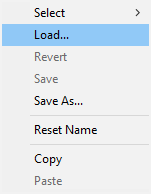
Main Toolbar Items

With the main toolbar you can access the following global functions:
- Dry/wet controls: activation and amount of dry & wet signals (lockable to avoid presets to change these values)
- General functions such as plug-in menu, undo/redo, user manual access, about box, described in details later in the manual.
- Tail spillover mode: activate tail spillover from the toolbar to play effects tail when bypassed. Also applies to sub sections (Pattern & Feedback Loops).
- Show/hide level meters.
- Open the presets browser.
- Show/hide assignable controls.
- Randomize: create random delay, based on the random option set for each section.
- "Panic!" clears audio buffers from all delay lines.
- Multicore pattern engine: activate multicore processing for the pattern section so that replies are processed on separate cores (improves performance when cpu-heavy plug-ins are loaded pattern slots).
- Lock GUI: prevent presets loading from changing the options of the graphical user interface (layout, random options...)
- EZ-mode: switch between easy and full editor user interface modes.
- Preferences Pane: show preferences for audio plug-ins.
The Easy Mode
The easy mode (activated by the "EZ" button) lets you browse presets and only adjust the main parameters. It is a great way to get started with the plug-in, or simply to enjoy the delays and reverbs that you have created, without being distracted by the details:
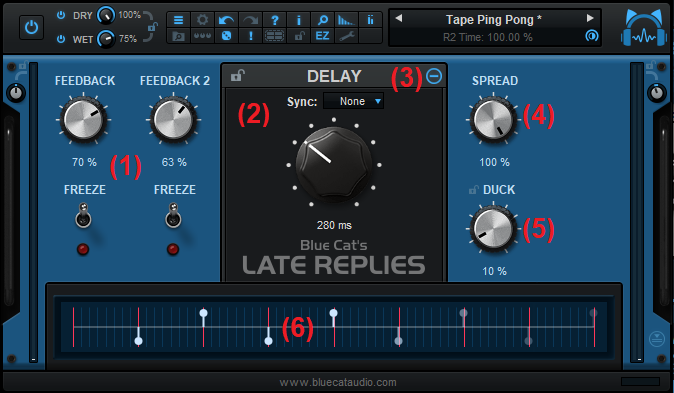
The controls displayed in easy mode may depend on the current preset: you may see only one or no feedback control if loops are not active or their controls are linked together, and the duck amount knob may also disappear if the duck module is not active. It adapts to the capabilities of the effect designed in full edit mode.
- Loops feedback and freeze controls: when feedback loops are enabled and not linked together, you can adjust the feedback and "freeze" each delay loop independently.
- Main delay controls: adjust the base delay length, and keep it in sync with the host. The wole section can be locked so that base delay settings remain unchanged while loading presets.
- Show / hide the delay/reverb topology details displayed in (6).
- Reduce the left/right spreading of the effect (may not affect the sound if the effect is initially mono) when decreased from 100%.
- Amount of ducking applied to the wet signal (visible only if the duck module is enabled in full edit mode).
- Delay/reverb topology display: each circle represents a reply (a.k.a. "repeat" or "echo"). Brightness reflects the volume of the reply, and its position on the graph its panning (upper side is left and lower side is right). Empty circles are out of phase compared to the input signal, and half filled circles represent an echo for which one channel is in phase and the other is out of phase.
Additional controls may appear at the bottom of the user interface if macro parameters have been created for the current preset.
You may find more details about these parameters and how they affect the signal in the next couple of paragraphs describing the full edit mode.
Browsing Presets
In order to browse both factory and user presets, you can either use the simple presets menu or open the full featured presets browser from the toolbar that remains visible until you close it:
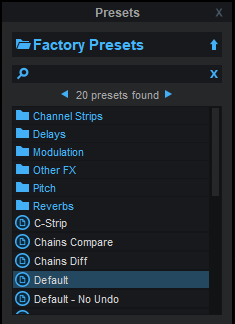
Click on preset files and folders to open them, or use the arrows to navigate between displayed presets. You can navigate upward in the folders tree by clicking on the current folder at the top. Type in the search box to find presets by name (it also searches in folder names). The search is performed recursively in the currently selected folder (displayed at the top).
Search Tips: you can search for multiple terms by separating them with commas. Wildcards are also supported (with * and ? characters), but they are applied to the full path of the preset. For example, to search for all presets containing the word "phase", type *phase* in the search box. To look for these presets only in the factory presets, you can type Factory Presets/*phase*.
Both global plug-in presets (main) and sub-presets for each module can be found in the preset browser - just click on the appropriate category to find them:
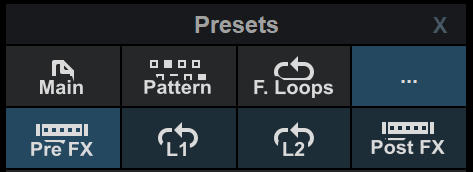
You can create your own presets by just combining presets from each module. It's a great way to experiment with effects, without getting into the details of the user interface in full edit mode that we will now explore.
Input Section
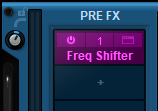
You can adjust the input gain and apply third party or built-in plug-ins to the incoming signal before being delayed.
Note: the input gain and effects are applied to the wet signal only - dry signal is not affected.
Base Delay Settings
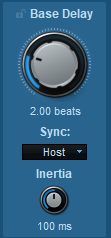
The global delay settings define the base delay time used by the pattern and loop sections. The delays set in these modules is relative to the base delay.
Three modes are available:
- Sync set to "None": the absolute value of the delay is set in milliseconds.
- With "Tempo" sync, you can choose a number of beats relative to a manually defined tempo.
- In "Host" sync mode, you can choose a number of beats relative to the tempo defined by the host application.
Note: in order to define precise delay values, hold the shift key down while dragging the knob or double click to enter a value.
The inertia parameter defines the time it takes to the delay to switch to a new value (the larger the value, the longer the tape-flutter effect when changing delay values).
The Pattern Module
The pattern module is a multitap delay with effects: the delay (relative to the base delay of the plug-in) can be set independently for each tap (called "reply" in this plug-in). For each reply the level, pan and effects can be set separately in the mixer.
Pattern Timeline

(1) The timeline is used to define the number of replies (delay taps) and delay times for each reply (named R1, R2,... R8). The duration of the whole timeline is the same as the base delay, as shown by the red vertical line on the right.
(2) Delay sliders on the timeline can be set to snap to an arbitrary grid (3). Choose the number of slices of the grid using the grid control. A "snap now!" button is also available to force snap existing delays without having to touch the sliders.
(4) In order to make changes to multiple replies at the same time, they can be linked together using either the link button at the far right of each delay time slider, or using the blue toggle link button at the top right. Note: links not only affect the delay time but also the level and pan of the replies.
(5) A randomize function can be used to create random settings when lacking inspiration. 3 modes are available:
- Full Pattern: randomize delay time, pan, level and phase inversion for all active replies.
- Sequence: randomize delay time for active replies.
- Levels: randomize pan and levels for active replies.
Click on the dice next to the mode selector to generate random values. If the snap to grid option is active, random times will conform to the selected grid.
(6) The menu button and arrows at the top left of the timeline lets you manage sequence presets: you can choose from factory presets for the timeline or save and reuse your own. These presets only contain timing information (the relative delays of the replies as well as their number).
Pattern Mixer
The mixer let you manage the levels and panning of each reply, as well a apply built-in effects or third party plug-ins:
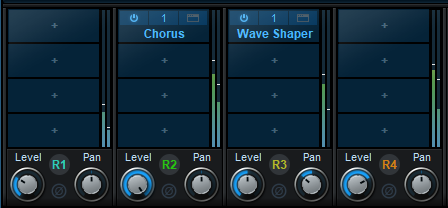
When replies are linked using the link controls in the timeline, the level and pan knobs are also linked together. The phase inversion button in the center of each mixer strip can be used to create replies with opposite phase. It can be useful to cancel replies or create phase effects when repeated in the loops section (two replies with the same level with opposite phase will cancel each other).
Note: even when the loops module is not active, you can visualize the impulse response generated by your pattern in the output graph of the loops section:

The Loops Module
The loops module contains two parallel feedback loops (echoes) that can interact with each other (cross-feedback). Both loops (L1 and L2) are identical.
Loops Timeline

(1) In the loops timeline you can define the pre-delay (blue) and delay time (green) for each feedback loop, and visualize the impulse reponse generated by both the pattern and loops modules (2). The OUT graph also reflects the value of the spread setting. Here again delays are all relative to the base delay time.
Just like for the pattern timeline, you can define a grid to snap to (3). Both loops can be linked together (4). The link not only apply to delay time, but also to all other parameters in the loop modules.
It is also possible to select the duration of the timeline with (5) (twice to eight times the base delay). Here too the red vertical lines show the base delay time. (6) is a brightness control for the output display.
(7) A randomize function can be used to create random settings when looking for inspiration (it is recommended to activate the limiters before using it!). 3 modes are available:
- Full Loops: randomize all parameters for both loops.
- Sequence: randomize pre-delay and delay time for both loops.
- Levels: randomize all parameters but pre-delay and delay time.
Click on the dice next to the mode selector to generate random values. If the snap to grid option is active, random times will conform to the selected grid.
(8) The menu button and arrows at the top left of the timeline lets you manage sequence presets: you can choose from factory presets for the timeline or save and reuse your own. These presets only contain timing information (the relative delays of the loops).
Individual Loop Sections
Both feedback loops are identical and have the same controls. They process the signal coming from the pattern module in parallel and they are summed together. They can also interact with each other, using the X-Feed (crossfeed) parameter described below.
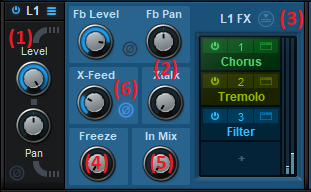
The black section in the GUI (1) contains the general mixing settings used to sum both loops together: level, pan and phase inverter. The power button can also be used to quickly disable the loop. Note that this is not equivalent to setting the level to 0: when the loop is disabled, crossfeed to the other loop is also disabled.
Next to each loop's power button and name is a menu icon. They are used to manage factory and user presets for each of the two loops independently.
Everything in the blue section relates to what happens inside the feedback loop:
- (2) loop feedback level, pan (how much every new repeat is panned), stereo crosstalk (0: no crosstalk / 50%: mono / 100%: channels are inverted) and phase inversion (each reply with revert its phase compared t previous).
- (3) effects and third party plug-ins can be applied inside the feedback loop: for every new repeat caused by the feedback, the effects will be applied again. A brickwall limiter can also be activated to avoid loosing control over the levels - mandatory if you are experimenting with effects inside the loop!
- (4) The freeze control lets you freeze what's inside the loop. But it is not just an on/off switch: you can choose the amount of "freezing" versus incoming signals from both input and crossfeed.
- (5) In Mix: volume of direct non-repeated signal processed by the loop effects. Typically the volume of the first repeat, not processed yet by the feedback loop, but processed by its effects.
- (6) Crossfeed: controls how much signal from the other loop is mixed with the loop's own signal (+phase inverter). From 0 to 100%, the amount of other loop's signal is increased (at 100% both loops are fed equally into the current loop). Above 100% the amount of the current loop is decreasing - at 200%, only the other loop is present in the feedback. You will typically use 200% on both loops to create a feedback chain, bouncing echoes from one loop to the other.
The Impulse Response Display
The output display is a handy tool to see what the impulse response of the delay generated by the plug-in looks like. It provides detailed information about the replies created by the plug-in:

Each circle represents a reply (a.k.a. "repeat" or "echo"). Brightness reflects the volume of the reply, and its position on the graph its panning (upper side is left and lower side is right). Empty circles are out of phase compared to the input signal, and half filled circles represent an echo for which one channel is in phase and the other is out of phase:

- In-phase reply (loud), almost centered.
- In-phase reply, panned left.
- Mixed reply, panned right (left channel in-phase, right is out of phase). Mixed replies will sound wider but their level will be reduced when switching to mono (or just reducing spread), since left and right channels are out of phase.
- Out of phase reply, panned left.
Why so much detail about the phase in the impulse response? It will help you find out quickly how replies will combine with each other when moving them around and activating the phase inversion switches. It is also helpful to understand phase cancelation effects that can reduce the level or cancel replies when combined together.
Ducking

Right before summing dry and wet signals, the wet signal goes thru the "ducker".
Using the envelope of the chosen signal (input or external side chain) defined by the attack and release controls, the wet (delayed) signal is reduced by the chosen amount, when the selected side chain signal is above the threshold.
You can activate or de-activate ducking by clicking on the title or the power button.
Locks
Several locks are available to prevent changes while loading presets: when the lock is active, loading presets will not change the parameters of a locked section. A general UI lock is also available in the toolbar, if you want to keep the same user interface settings (GUI layout, spectrum view options, reference curves) while browsing presets.
Using Built-in Effects, VST, VST3 or Audio Unit Plug-Ins
Note: before inserting VST plug-ins, it is strongly recommended that you setup your main VST plug-ins directory in the preferences pane, as detailed later in this manual (this setting does not affect VST3 plug-ins).
Warning: in a 64-bit application you can only load 64-bit plug-ins, and in a 32-bit application you can only load 32-bit plug-ins, unless your are using a third party bridging application.
Each plug-in slot lets you insert a plug-in. When clicking on an empty slot, the following menu appears:
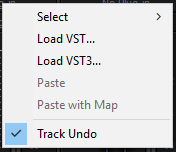
The "Select" item lets you load built-in effects, or choose a favorite third party plug-in directly from the menu if you have saved any.
Selecting "Load VST" will open a standard system window where you can select the VST plug-in you want to load. If the preferences have been properly set, the window should open the appropriate location where you can find the VST plug-ins.
Selecting "Load VST3" will open a standard system window where you can select the VST3 plug-in to be loaded.
On Mac, an additional "Load AU" menu item is available to load Audio Units. It opens a file open dialog in the standard location for Audio Units on your system. Note: if you want to load the system Audio Units provided by Apple, you will need to open the CoreAudio component located in the /System/Library directory (/System/Library/Components/CoreAudio.Component).
You can also choose to paste an existing VST, VST3 or AU plug-in if previously copied into the system clipboard from another slot. When using the "Paste with Map" command, if the plug-in in the source slot had mapped parameters, these parameters will be added to the map until no more assignable parameters are available.
Once a plug-in has been loaded into a slot, a mouse click will display the following plug-in menu that offers various controls over the plug-in:
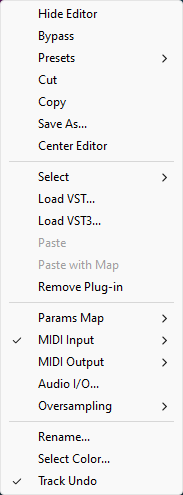
- Show (Hide) Editor: display or hide the plug-in's user interface.
- Bypass: toggle bypass for the plug-in.
- Presets: access the plug-in's factory presets if any, and load/save presets files in the plug-in's native format (fxb/fxp, vstpreset or aupreset).
- Cut: copy the plug-in and its settings into the system clipboard and remove it from the slot.
- Copy: copy the plug-in and its settings into the system clipboard. Onced copied, it can be pasted to any other slot, in any instance of the Late Replies plug-in (even in a different application).
- Save As: save the plug-in in the slot and its settings as a favorite. Favorites are saved in the plug-in documents folder and can be organized using folders to appear later in sub menus.
- Center Editor: bring back the editor of the plug-in to the center of the screen, in case you cannot find it.
- Select: select a plug-in and its settings from the favorites list.
- Load VST: load another VST plug-in in the slot (will replace the existing plug-in if any).
- Load VST3: load another VST3 plug-in in the slot (will replace the existing plug-in if any).
- Load AU (Mac only): load another Audio Unit plug-in in the slot (will replace the existing plug-in if any).
- Paste: paste a plug-in and its settings from the system clipboard into the slot.
- Paste with Map: paste a plug-in, its settings and mapped parameters from the system clipboard into the slot. Parameters are re-mapped in order, until no more assignable parameter is available.
- Remove Plug-in: remove the plug-in from the slot.
- Params Map: lists the plug-in's parameters that can be mapped for automation, and lets you assign them to external controls (see the next paragraph).
- MIDI In: select the MIDI port(s) this plug-in is receiving data from (see below).
- MIDI Out: select the MIDI port(s) this plug-in is sending MIDI data to (see below).
- Audio I/O: opens the audio i/o routing window for this plug-in (see below).
- Oversampling: select oversampling ratio and quality for the plug-in (see below).
- Rename: rename the instance of the plug-in. Setting an empty name reverts back to the plug-in's default name.
- Set Color: open the system color dialog to select the color for the plug-in slot.
- Track Undo: toggle undo tracking for the slot. If enabled, inserted plug-ins changes will be inspected and added to the Late Replies plug-in undo history when possible. Please note that some plug-ins may not work properly when this feature is enabled. It is also recommended to disable this feature when controlling a plug-in with MIDI events generators such as Blue Cat's DP Meter Pro or Remote Control.
Once a plug-in has been loaded into a slot, the following buttons are available:
Clicking on the power button on the left will bypass/unbypass the plug-in in the slot. The button on the right can be used to show/hide the plug-in's editor.
Missing Plug-Ins
In some cases, it may happen that you are working on a workstation that does not have all plug-ins that were previously loaded into your Late Replies session. In this case, the Late Replies plug-in will display a "Missing Plug-in" message on corresponding slots. You can still continue working on your session: the Late Replies plug-in will retain the state of the missing plug-ins as if they were here. The session can be saved later: the data for missing plug-ins will be saved as well, and the session can be restored later without losing data.
For VST and VST3 plug-ins, if the plug-in is missing because of a path issue (the plug-in is located in another directory, or the 64-bit version has a different name from the 32-bit version...), you can choose to relocate the plug-in:
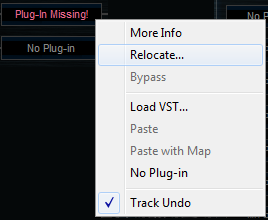
This lets you find the plug-in on your workstation and re-link to it. The state of the plug-in that was previously saved in the preset or the session will be restored, making sure all data is kept.
Note: the plug-in chosen with the relocate function has to be compatible with the plug-in that was originally loaded in this slot. Relocation will fail otherwise.
Mapping Parameters (One To One Quick Mapping)
The "Params Map" item in the plug-in menu lets you map sub plug-in parameters so that they can be automated or controlled with an external control surface. It also lets you view existing mapping for this plug-in if any:
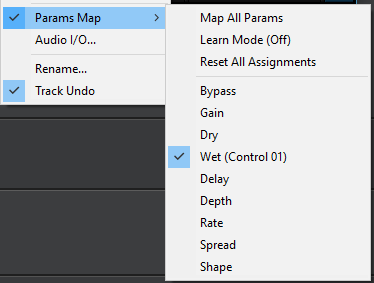
- Map All Params: assign all parameters of this plug-in to remaining controls (in the same order as exposed by the plug-in). The maximum number of parameters that can be mapped is 20.
- Learn Mode (on/off): when learn mode is on, touching a control in your plug-in's user interface will automatically add it to the parameters map (if the plug-in supports it). Once you are done with parameters assignment, you may want to disable learn mode to avoid mapping unwanted parameters.
- Reset All Assignments: removes all assigned parameters from the params map, for this plug-in. This frees all controls used by previously assigned parameters (for this plug-in only).
- All parameters available for assignment are then displayed in the menu. Clicking on a parameter toggles mapping on or off. When a parameter is mapped, the name of the external control (as displayed in the host application) appears next to it, inside parentheses.
Parameters Mapping works the following way: 20 parameters are available for mapping in Blue Cat's Late Replies. They are named "Control 01" to "Control 20". When a sub plug-in parameter is selected for mapping, the first control available within Blue Cat's Late Replies is used. Once mapped, the sub plug-in parameter and this control are linked together, so that any change to either of them is reported to the other.
This enables the sub-plug-in to expose its parameters to the outside of the Late Replies plug-in. You can for example use these external controls for automation, MIDI control , control surface assignment etc.
If assigned controls are shown in Blue Cat's Late Replies ("Show Assigned Controls" button), new knobs will appear when new parameters are mapped, until the maximum number of 20 controls is reached.
It is possible to choose the style of the knobs using the menu, and set the name of each control by clicking on it:
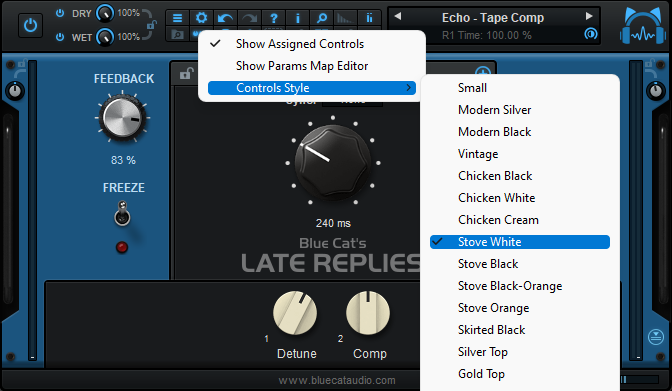
These custom names should be displayed in the host application in place of "Control 01, Control 02..." if it supports it.
Macro Controls: The Parameters Map Editor
It is possible to access more advanced options for parameters mapping and create macro controls assigned to multiple parameters from multiple plug-ins by launching the Params Map Editor:
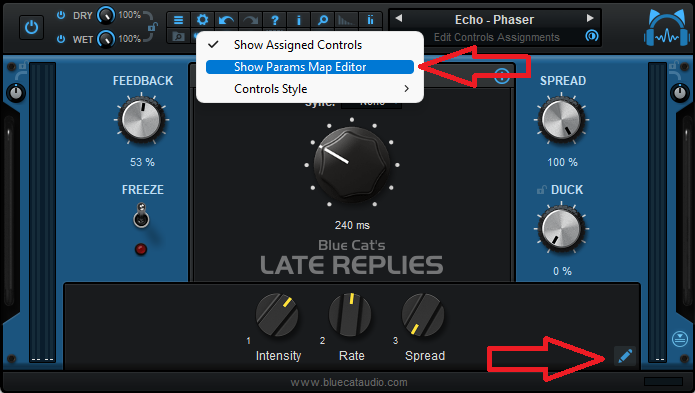
The Map Editor is displayed in a separate window that you can re-size at your convenience:
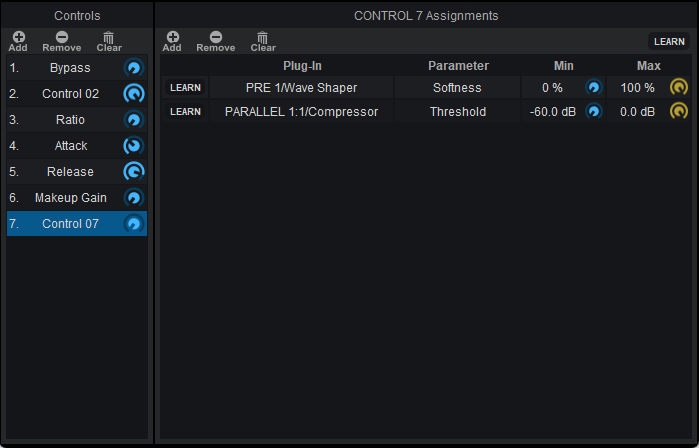
Available controls are displayed on the left (you can add or remove them with the icons on at the top), and when a control is selected you can see the parameters that have been assigned in the pane on the right.
Assignments can either be created manually (using the "Add" icon and then selecting the plug-in and parameter in the menus), or automatically with the learn button at the top right of the pane. When this assignment learn function is engaged, clicking or moving a knob of a plug-in should add the corresponding parameter to the list. Do not forget to disengage it when you are done or unwanted parameters might be added when touching the plug-ins later!
It is also possible to learn parameters individually using the learn button on the left of each line.
Once parameters have been added, their range can be adjusted using the knobs on the right (or by double clicking on the value). To reverse the range, simply invert the min and max values (using a min value that is larger than the max value).
You can also change the name of the controls by double clicking on them in the list displayed in the left pane.
It is also possible to change the order / add parameters by dragging and dropping items in the left column (it works between different instances too).
Internal MIDI Routing
Blue Cat's Late Replies lets you build your own MIDI connections between inserted plug-ins and the host application. Each slot can be connected to multiple ports to receive and send MIDI events:
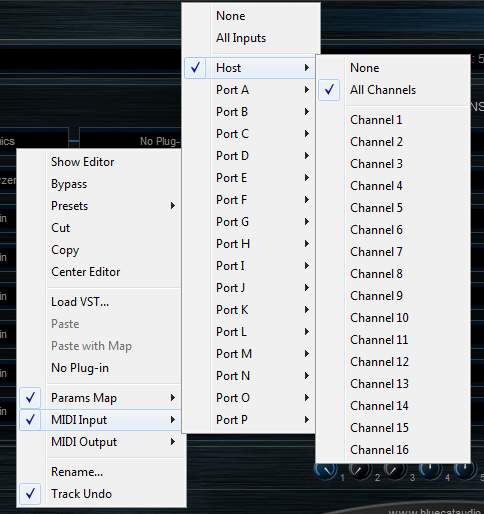
- Host: this port connects to the host application to send (MIDI Out) and receive (MIDI In) events. By default, all slots have their MIDI input connected to the Host.
- Port A to Port P: these are virtual ports that can be used to connect sub plug-ins together.
For the MIDI input of a plug-in you can additionnaly choose to filter events by channel so that it receives all events for one or several selected channels only. If you just want the plug-in to receive all events without any filter, choose "All Channels" for the selected port.
Using virtual internal ports is simple: connect the output of a plug-in to a port, and the input of another plug-in to the same port. The two plug-ins will then be able to exchange MIDI data (from sender to receiver). Multiple plug-ins can be connected to the same port (as input or output). MIDI events will be gathered from MIDI Outs and redistributed to to all connected MIDI Ins.
However, there is a limitation in which plug-ins can be connected together:
- it is not possible to create feedback loops.
- only a plug-in that processes audio data before another can send MIDI data to this plug-in. It means that a plug-in can receive MIDI data from plug-ins that are located earlier in the audio processing chain only (see the signal flow above). If the plug-in is located in a parallel chain, it can also receive MIDI data from plug-ins that are located in parallel chains above it.
These limitations ensure causality and perfect synchronization of MIDI data exchanged between plug-ins, without latency.
Note: when connecting a plug-in to control its parameters via MIDI, you may want to disable undo tracking on this plug-in, to avoid that to many undo steps are recorded by Blue Cat's Late Replies and reduce CPU usage.
Audio I/O Routing
Using the "Audio I/O" command in the plug-in menu, it is possible to manually change which audio channels are processed by each plug-in.
Automatic Selection
By default, Blue Cat's Late Replies will automatically detect the number of channels to use for each plug-in depending on its own configuration: effect plug-ins will process only the main audio channels and leave aux and side chain channels unaffected. Plug-ins which appear to have a side chain input will receive the side chain channels. Plug-ins with aux outputs will be connected to aux channels if Blue Cat's Late Replies is configured with aux outputs too.
About mono plug-ins: in automatic mode, mono plug-ins will process only the first audio channel, and the wet mono output will be copied to all channels of the main bus (aux and side chain unaffected). If you want to only apply the plug-in to one of the incoming audio channels instead, you can use the manual configuration.
Manual Selection
Automatic detection may however not work properly for some plug-ins, and you may want to change which channels the effect applies to (for multi-mono effects, or to process aux channels for example). That's what the audio I/O window is for:
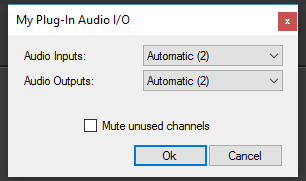
When selecting a specific number of inputs and/or outputs instead of using "automatic", you can choose which channels are connected to each i/o for this particular plug-in:
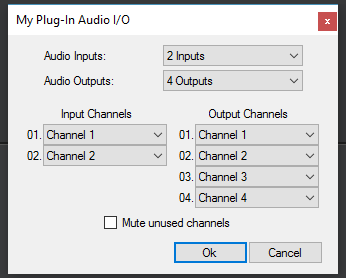
- if the same channel is selected for multiple outputs, only the last selected plug-in output will be audible (plug-in outputs are not summed).
- By default, all channels that are not used as outputs by the plug-in remain unchanged (copied from the same channels before the plug-in). For example, on a stereo configuration, if a mono plug-in is set to process only channel 1 and use channel 1 as output, channel 2 will remain unaffected. Select "mute unused audio channels" to mute these unprocessed channels instead.
Auto vs Manual
In automatic mode, Blue Cat's Late Replies will automatically choose the best configuration according to its own audio layout. This is very useful if you are saving your plug-in chains to reuse them with different audio i/o configurations.
In manual mode, the number of inputs and outputs of the selected plug-in is selected and will not change. It means that you may not be able to use this particular configuration later with another number of audio channels.
Oversampling
Starting Late Replies 1.65, it is possible to have a plug-in process audio (and MIDI) at higher samplerates. You can select the oversampling ratio and resampling quality with the oversampling menu:
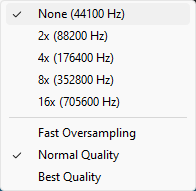
Oversampling can be useful for plug-ins doing non-linear processing (distortion, compression...) which do not have built-in oversampling capabilities and cause artefacts (aliasing). It may also benefit EQs (you can get smoother curves in the upper frequencies).
Oversampling may however result in other types of artefacts and will require more CPU to process the same amount of data. With high quality resampling, additional latency may also apply.
Warning: please note that some third party plug-ins may not support higher sample rates. Save your work before trying this feature on new plug-ins!
Note: The oversampling settings are saved when using the "Save As..." command to save the plug-in as a favorite.
The Preferences Pane

In the preferences pane, you can set the default VST plug-ins path by clicking on it or on the button labelled "...". This VST plug-ins directory is used for several purposes:
- It is the default directory that is opened when you want to load a VST plug-in.
- It is used as the root path when saving/loading presets that include VST effects: the path of VST plug-ins is saved relatively to this root path, so that you can reopen your sessions on different machines that may have different VST paths (typically on a Mac and a PC).
If you happen to have your VST plug-ins installed in several paths, we advise you to choose the VST path that contains most of your plug-ins. You can then use the "User VST plug-ins directory" to define an extra location for plug-ins. This extra path will be used by the Late Replies plug-in as an alternative root path to load and save the plug-ins.
Please note that these paths are used for VST2 plug-ins only - they do not affect the location of VST3 plug-ins.
If the "Restore plug-ins editors on open" option is checked (default), when the Late Replies plug-in is opened, inserted plug-ins user interfaces will be restored at the same position as when the Late Replies plug-in was last closed. If the option is unchecked, all plug-ins user interfaces will be kept closed when re-opening the Late Replies plug-in, and their position on screen will not be saved.
When the "plug-ins editors always on top" option is checked, the windows of the hosted plug-ins will be kept on top of all other windows. It can be useful when you want to make sure the hosted plug-ins remain visible all the time. Also, if you are using Cubase on Windows, you may want to check this option to fix the erratic behavior of Cubase's own "always on top" option.
Drag and drop support
The user interface supports drag and drop to manipulate plug-ins easily:
- drag and drop plug-ins between slots (copy or move).
- hold the alt key on Mac and Ctrl key on windows to copy (duplicate) a plug-in instead of moving it.
- drop the plug-in before another to insert it in the chain
- drag and drop plug-ins between several instances of Axiom or accross plug-ins (compatible with the latest preview of Late Replies, MB-7 Mixer and PatchWork).
- drag and drop .dll, .vst, .vst3, or .component files directly from the Finder or Explorer onto plug-in slots.
- drag and drop .plgnfo files (previously saved from the software) directly from the Finder or Explorer onto plug-in slots.
The various elements of the user interface (knobs, sliders, buttons...) are simple and intuitive to operate, but more information about how to interact with them is available in the "Plug-ins Basics" chapter of this manual.
Operation
This section describes several common use cases for the plug-in. A complete list of the parameters exposed by the plug-in is available in the next section.
Exploring the Presets
The plug-in offers a very wide range of capabilities, so you may want to first browse the presets to give you an idea of what it can do. An existing factory preset that you like is also a good starting point to create your own.
Tip: when listening to a preset, you may want to change the base delay settings to adapt to your song. You will also probably want to adapt the dry and wet amounts.
Once you are familiar with a few presets, you can also lock elements you are happy with (ducking / dry-wet controls / in and out gains or the entire GUI), before trying other presets.
Each module and their sub sections also have their own factory presets, so you can quickly build new sounds with combinations of them, before even moving a single dial.
Creating Unique Rhythm Patterns
The plug-in can be used to quickly build complex and attractive rhythm patterns: you will typically start with a simple sequence in the Pattern module and use the feedback loops to either repeat the pattern over time (larger loops delays), or make it more complex (shorter loops delays, using crossfeed and phase inversion).
In many cases, you will want to work with the base delay synchronized to host tempo to make sure yuor rhythm patterns are in sync with your song.
Using the Grid
Using a grid with the appropriate number of divisions (and "snap to grid)" enabled) makes it simpler to create your pattern:

Different grids can be used for the pattern and loops sections.
Phase Inversion is your Friend
The multiple phase inversion buttons available in the user interface will let you create taps (replies) or feedback loops that are out of phase. Once you have a simple pattern that you like, you can experiment with these switches to make the pattern more complex: some taps will cancel each other, or if panned differently, will generate out of phase stereo replies.
You may have to adjust the levels of the replies and loops to get exact phase cancelation. Just look at the output impulse display to check when some of the replies disappear.
Accents
There are two ways to create accents in rhythm patterns with the plug-in: you can either alter the level of the replies in the pattern section (make a reply louder than others to get an accent), or arrange the feedback loops so that replies combine with each other at a louder level.
Also, experiment with panning: subsequent replies will produce a different rhythmic feel if panned left and right rather than centered.
Human Feel
All right, so you have a nice rhythm pattern, but it sounds a bit robotic? You can add some human feel to it!
First, disable the "snap to grid" option, and move the taps around (but keep them close to their initial locations):

You can choose to make replies late or in advance by moving them right or left. This is aslo applicable to the loops section.
Another way to add human feel to the rhythm pattern is to modulate the delays at a slow rate, so that the pattern "moves" around over time. Delay modulation can be achieved with the included chorus effect (see Delay Modulation).
Use Delays
To create triplet fills or complex patterns more quicly, you can use the included multitap delay effect: it can also be synchronized with the host and will let you build simple rhytmic figures inside an existing pattern.
Adding Some Melody
With the included pitch shifter effect or a third party plug-in, you can create melodic patterns too!
Check out the "Melodic Patterns" presets: play a single note and listen to the melody. You can use this technique to simulate an arpeggiator on any kind of sound.
One or more pitch shifters inside the feedback loops can also create very interesting arpeggiating effects.
Creative Reverbs
With its two nested feedback loops including effects, the plug-in can act as a minimal feedback delay network (FDN).

If it cannot rivalize with dedicated reverb algorithms for ultra-realistic or transparent reverbs, it can produce very interesting results, as you can hear in the presets. It is the only plug-in that will let you insert any kind of processor in its feedback loop!
Delay Modulation
To add modulation on a specific delay line in the plug-in, just insert the chorus effect, with the mix parameter set to 100%: it will simply add a modulated delay that you can control from the chorus plug-in.
Of course, it also works inside the feedback loops. And you can use several instances of the chorus effect in series to create more complex modulation.
Create Your Own Custom Delays
Use the macro parameters to create simple controls that let you modify the main aspects of your custom delay effect, and switch to easy view. Hiding the complexity under a simple user interface, you can forget about the signal flow and focus on the sound of the delay/reverb effect.
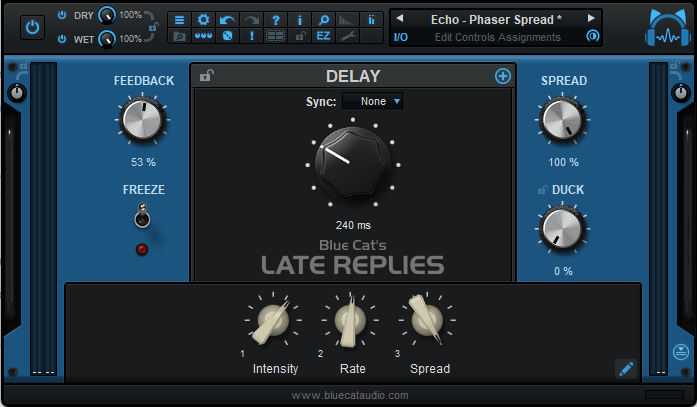
More Creative Tips
Use Module Presets
Randomness
Use Links
Links are available to modify multiple replies simultaneously in the pattern module and operate on both loops at the same time. Use them!
Using a Silent Loop as a Buffer
Set the level of one of the feedback loops to 0, then play with crossfeed between loops: the silent loop, still active, will act as a bouncing buffer for the other one, and you won't hear its own signal.
Load Late Replies Into Itself
Blue Cat's Late Replies is also available as a built-in plug-in (checkout in the the Delay category), so you can load it into itself and share the presets without the need to install a specific version (VST, VST3 or AU).
Extend with Plug-Ins
While you can already do quite a lot with built-in effect plug-ins, there is a huge range of third party plug-ins available in VST, VST3 or AU formats that can be inserted into this plug-in to expand its capabilities. Insert your favorite plug-ins inside the feedback loop: it will definitely sound different to what you have been used to!
Blue Cat Audio Plug-Ins Basics
This chapter describes the basic features that are common to all our plug-ins. If you are already familiar with our products, you can skip this part.
User Interface Basics
About Skins
Like all Blue Cat Audio plug-ins, Blue Cat's Late Replies uses a skinnable user interface. It means that the appearance and behavior of the user interface can be entirely customized.
Especially with third party skins, the experience may be quite different from the one offered by the default skins that we provide. However, our plug-ins and our skinning engine have several standard features that will be available whatever your favorite skin.
More information about custom skins can be found in the skins section.
The Main Toolbar
In most skins, an optional toolbar at the top of the user interface gives you access to the main options and settings of the plug-in:

Smooth Bypass
On the left, the power button can be used to smoothly bypass the plug-in.
Presets Area
At the center of the toolbar, you can see the current preset area (the "Default Settings" box). It displays the name of the current preset, with a "*" at the end if it has been modified since loaded.
The arrows on the left and right let you navigate thru the (factory and user) presets available for the plug-in.
Clicking on the preset name opens the presets menu which lets you manage the presets of the plug-in.
Using the knob on the bottom right of this area, you can reduce the opacity of the window, and make it transparent (the actual result may depend on the host application). Additional messages may appear in the area next to this knob, depending on the plug-in.
Some plug-ins may also propose you to manually select the audio I/O inside the plug-in (bottom left of the presets area), regardless of the host configuration. It can be useful for example to save CPU by selecting mono to stereo configurations (instead of full stereo sometimes chosen by default by the host), or add extra channels to manage side chain internally, when the host does not provides any side chain input. Please note that this does not change the number of I/O seen by the host application.
Commands
The icons in the toolbar give you access the to the following commands that are detailed in the next paragraph:
| Icon | Name | Function |
|---|---|---|
|
|
Menu | Open the main menu |
|
|
Control Settings | Display the controls settings menu (to manage automation and MIDI control, as described here). |
|
|
Undo | Undo |
|
|
Redo | Redo |
|
|
Manual | User Manual |
|
|
About | About |
|
|
Zoom | Scale the user interface (from 70% to 200%). |
The Main Menu
The main menu is available from the main toolbar, or if you right click anywhere on the background of the plug-in:
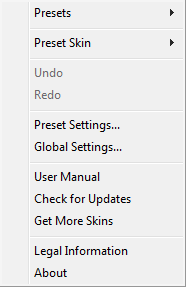
- Presets: opens the presets menu to manage presets.
- Preset Skin: opens the skins menu to choose the skin for the current preset and manage alternative skins for the software.
- Undo/Redo: undo or redo the latest modifications. This includes all changes made to the current preset settings such as MIDI or automation preferences.
- Presets Settings: open the presets settings window. It lets you change the skin, MIDI and automation settings for the current preset.
- Global Settings: open the global settings window. It lets you change the skin, MIDI and automation settings that are used by default in all instances of the plug-in (if not overridden by the current preset).
- User Manual: open this user manual.
- Check for Updates: opens up our website to let you check if any update for this software is available.
- Get More Skins: get more skins for this software.
- Legal Information: browse licensing and misc legal documents.
- About: displays the “about” dialog box.
Controls
Examples
Here are a few examples of typical controls you will encounter in the user interface of our plug-ins:
| slider | slider | knob | button | Text control |
|
|
 |
 |
|
|
Interacting with Controls
You can interact with the controls of the plug-in interface either with the mouse or the keyboard.
Setting the keyboard focus on a control (so that it responds to key strokes) may be automatic (when you pass the mouse over it it gets focus) or manual (you have to click on the control to set the focus on it). Note that all host applications behave differently regarding keyboard handling. In some applications you may not be able to use all keys described later in this manual to interact with our plug-ins. It is usually made obvious to you to know the active surfaces of the skin (the places where you can click with the mouse): the mouse cursor usually changes when you can do something on a control. In the default skins delivered with the plug-in, the cursor changes to a small hand or an arrow to tell you when your mouse is over an active control.
Mouse
Various mouse movements will let you interact with the controls:
| Mouse Interaction | Action |
|---|---|
| Left Click | Acquire focus and start dragging or push (button) |
| Left Click + Alt Key | Set the value to default |
| Left Double Click |
Acquire focus and launch the “fine
tuning” edit box (except button):
 |
| Right Click | Set the value to default |
| Mouse Wheel | Increment or decrement the position (focus required) |
| Mouse Drag | Change the control position depending on mouse movement (except button) |
Keyboard
All control widgets support the following keys (note that some of them are caught by the host and thus never forwarded to the control. For example in Steinberg Cubase SX you cannot use the arrow keys to control the plug-in):
Keys Common to All Controls
| Key | Action |
|---|---|
| Up Arrow | Small increment of the position (up or right) |
| Down Arrow | Small increment of the position (down or left) |
| Left Arrow | Same as Down Arrow |
| Right Arrow | Same as Up Arrow |
| Page Up | Large increment of the position (up or right) |
| Page Down | Large decrement of the position (down or left) |
| + | Small increment of the value of the control |
| - | Small decrement of the value of the control |
| d | Set to default value (same as mouse right click) |
| e |
Opens the 'fine tuning' window to precisely
set the parameter:
 |
| SHIFT | When the key is down, the fine tuning mode is on, and you can modify the value with better precision when moving the mouse, the mouse wheel or using the keyboard. Just release the key to get back to the normal mode. |
Keys Specific to Buttons
| Key | Action |
|---|---|
| Enter | Pushes the button |
Presets
To get started with the plug-in and discover its capabilities, a couple of factory presets are provided. You can also save your own presets and recall them later for other projects. Our plug-ins propose a full-featured preset manager to let you save, browse, organize and recall its presets.
The Presets Menu
The presets menu can be opened from the main menu or the main toolbar. It displays the list of presets available for the plug-in as well as commands to load, save or organize presets:
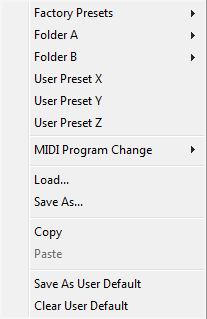
- Factory Presets: shows the list of factory presets delivered with the plug-in.
- "Folder A" to "User Preset Z": user presets and categories.
- MIDI Program Change: activate MIDI Program Change support (see below).
- Load: load preset from file.
- Save: save current state to last loaded user preset.
- Save As: save current preset to a file.
- Copy copy preset to the system clipboard.
- Paste paste preset from the system clipboard, if available.
- Save As User Default: save the current state as the default preset. This preset is used every time a new instance of the plug-in is created.
- Clear User Default: reset the default preset to its factory state: this makes the plug-in forgets the custom settings you might have saved as a default preset.
More about Presets
There are two types of presets: factory presets (read only) that are provided with the plug-in, and user presets that can be created and stored by the user.
The user presets are stored in a subdirectory of the documents folders of your profile ("Documents" on Mac, and "My Documents" on Windows): Blue Cat Audio/[Plug-in Name]/Presets. Each preset is stored as an individual file. You can create folders and subfolders in the Presets directory to classify your presets, as shown in the example below:

If you save a preset named "Default" in the root Presets directory, it will override the factory default preset (that's what "Save As Default" does). To restore the factory default preset, you can just remove this file or use the "Reset Default" command.
MIDI Program Change
It is possible to load presets remotely using MIDI "Bank Select" and "Program Change" messages. To enable this feature, select a MIDI channel to receive the events from in the MIDI Program Change menu item from the presets menu:
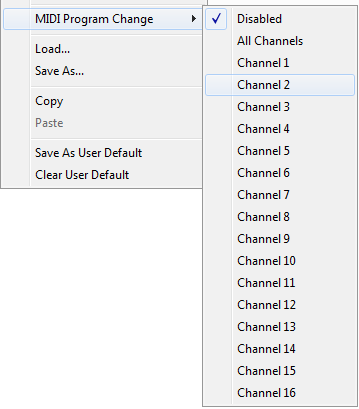
This setting is saved for each plug-in istance with your session but not in presets (except for the default preset, using the "Save as User Default command"). Once activated, the plug-in menu will display the bank number followed by the preset number for each preset:
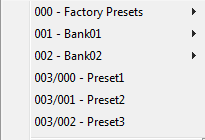
Every root folder is considered as a new bank, starting with the factory presets (bank 0). Program and bank numbers may change while you add folders and presets, so you should be careful when naming them if bank and program numbers matter to you. It is recommended to use folders to make this task simpler. As a side note, sub folders do not define additional banks (all presets contained in sub folders are associated with the current bank.
As specified by MIDI, bank select messages are not used until a program is actually selected.
MIDI Implementation note: the software supports all types of Bank Select methods. You can use either MIDI CC 0 or MIDI CC 32 to select banks. If both are used simultaneously, they are combined together so that you can use more banks (in this case CC0 is LSB and CC32 is MSB, and actual bank number is 128*CC0+CC32).
MIDI and Automation Control
Blue Cat's Late Replies can also be remotely controlled via MIDI using MIDI CC ("Control Change") messages or automation curves, if your host application supports it. It is possible to customize the channel, control numbers, range and response curve used for each parameter in the settings panel available from the main menu (see the Plug-in Settings chapter for more details).
MIDI and Automation Settings Menu
The main menu
Most skins also provide the ability to change MIDI and automation settings directly in the main user interface. Clicking on the control settings icon in the main toolbar opens the following menu:
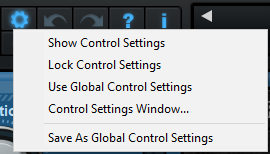
- Show Control Settings: show direct access to individual control settings for each parameter in the user interface (see next paragraph).
- Lock Control Settings: lock the current controls settings for MIDI and automation so that they remain unchanged when loading presets.
- Use Global Control Settings: ignore the current MIDI/automation settings and use the global settings instead.
- Control Settings Window: display the control settings window, to change control settings for all parameters.
- Save As Global Control Settings: save the current settings as global settings (used by default, when no specific MIDI/Automation setting has been set for the cuirrent preset).
Individual Control Settings
When this feature is activated using the "Show Control Settings" item in the MIDI and Automation Settings menu, dropdown menu buttons appears next to the main controls displayed by the plug-in:
Clicking on this button shows the MIDI/Automation settings menu:
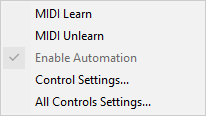
- MIDI Learn: launches MIDI learn mode for the control: touch your MIDI controller and the control will learn from it the MIDI channel and CControl Number. To end the learn mode, reopen this menu and deselect the option.
- MIDI Unlearn: deactivates MIDI control for this parameter.
- Control Settings: launches the advanced settings panel described below. This controls the settings for the current preset.
- All Control Settings: display the control settings window, with access to all parameters.
Advanced MIDI and Automation Settings
You can completely customize the way the plug-in is controlled by automation and MIDI. For a global view of all parameters at a time, you can use the Plug-in Settings window for the current preset which is available from the main menu.

MIDI Settings:
- Enable MIDI: enable/disable the MIDI control of the parameter.
- Channel: MIDI Channel for the parameter control. If set to 0, the plug-ins will accept Control Change Messages from all MIDI Channels (MIDI Omni mode).
- CC: Control Change Number.
- Learn: click on this button to activate the MIDI learn functionality. When it is activated, you can move your MIDI controller, and the plug-in will automatically detect the control settings .
MIDI and automation settings:
- Response: response curve of the MIDI or automation control: from very fast to slow control.
- Min: minimal value of the parameter when MIDI controlled or automated.
- Max: Maximum value of the parameter when MIDI controlled or automated.
Note: if the Min value is higher than the Max value, the response curve will be reversed: increasing the control value will decrease the parameter value.
Note: if you double click on the parameter text control boxes for the max and min values, a “fine tuning” edit box will appear and let you change the min and max values with more precision:

More
Check our online tutorial for more screenshots and more examples of our plug-ins user interfaces.
Blue Cat's Late Replies Parameters
All parameters described below can be automated and controlled via MIDI if your host application supports it. You can precisely define this behavior in the settings panels described later in this manual.
The parameters of this plug-in exposed for automation and MIDI control are described below:
| Name | Unit | Description |
|---|---|---|
| General | ||
| Bypass |
|
Bypass the effect. |
| Dry On |
|
Enable dry (unprocessed) signal path. |
| Dry | % | Amount of dry signal (when enabled). |
| Wet On |
|
Enable wet (processed) signal path. |
| Wet | % | Amount of wet signal (when enabled). |
| Meters On |
|
Enable level meters. |
| In Gain | dB | Input gain for the wet signal path. |
| Flush |
|
Flush delays when changed (panic). |
| Base Delay Settings | ||
| Dly Sync |
|
Choose delay sync mode (none / Tempo / Host). |
| Dly Time | ms | Delay time in milliseconds - used when sync mode is set to "None". |
| Dly Beats | beats | Delay time in beats - used when sync mode is set to "Host" or "Tempo". |
| Dly Tempo | bpm | Tempo used in "Tempo" sync mode. |
| Dly Inertia | ms | Inertia of the delay lines: time to update to new delay value when changed. The larger the value, the longer the "Wow" effect when changing delays. |
| Pattern Module | ||
| Pattern |
|
Enable PATTERN module. |
| Pattern Mix | % | Amount of signal processed by the pattern module vs pattern module input. |
| Replies |
|
Number of replies for the PATTERN module. |
| Rx Time | % | Delay time for reply #x (in proportion to base delay). |
| Rx Level | % | Level (volume) for reply #x. |
| Rx Pan | % | Stereo pan for reply #x. Use positive values for right panning and negative for left. |
| Rx Invert | % | Invert phase of reply #x. |
| Feedback Loops Module | ||
| Loops |
|
Enable FEEDBACK LOOPS module. |
| Loops Mix | % | Amount of signal processed by the loops module vs loops module input. |
| Lx Enabled |
|
Enable loop #x. When disabled, a loop produces no sound and is not used for the other loop crossfeed either. |
| Lx In Mix | % | Amount of direct non-repeated signal processed by the loop effects. Typically the volume of the first repeat, not processed yet by the feedback loop, but processed by its effects (and pre-delay). |
| Lx Pre Delay | % | Pre-delay time for loop #x (in proportion to base delay). |
| Lx Time | % | Delay time for loop #x (in proportion to base delay). |
| Lx Feedback | % | Amount of signal re-injected into loop #x. The larger the value, the more repeats the feedback loop will produce. |
| Lx Fb Invert |
|
Invert the phase of the signal re-injected into loop #x. |
| Lx Fb Pan | % | Stereo pan for the signal re-injected into loop #x. |
| Lx Stereo Xtalk | % | Stereo crosstalk for signal reinjected into loop #x. Pure mono signal is obtained at 50%, and stereo inversion at 100%. |
| Lx Freeze | % | Amount of "freezing" for feedback loop #x. At 100% the feedback loop is fully frozen (acts as a looper). |
| Lx Level | % | Output level for loop #x. |
| Lx Pan | % | Output stereo pan for loop #x. |
| Lx Invert |
|
Ouput phase inverter for loop #x. |
| Lx XFeed | % | Loop Crossfeed: amount of signal from the other loop reinjected into Loop #x. Above 100%, reduces the amount of signal from loop #x re-injected into itself. At 200%, only the signal from the other loop is fed back into loop #x. |
| Lx Xfeed Invert |
|
Invert the phase of the signal from the other loop fed back into loop #x |
| Lx Limiter |
|
Enable the brickwall limiter inside feedback loop #x (to avoid overshoots). |
| Output Section | ||
| Spread | % | Global stereo spread control for the wet signal. Use it to reduce the stereo width of the delays and inserted effects. Wet signal becomes mono at 0%. |
| Duck |
|
Enable Wet signal ducker. |
| Duck Source |
|
Signal used to duck the wet signal: plug-in input or external side chain signal (if connected and host supports side chain). |
| Duck Attack | ms | Time for the ducker to start reducing the wet signal when the source is above the duck threshold. |
| Duck Release | ms | Time for the ducker to reach unity gain (fully stop reducing the wet signal) when the source is below the duck threshold. |
| Duck Threshold | dB | Threshold above which the gain reduction of the ducker is triggered. |
| Duck Amnt | dB | Amount of gain reduction for the ducker. |
| Out Gain | dB | Gain applied at the output of the plug-in, after dry and wet signals have been summed. |
| Limiter |
|
Enable the output brickwall limiter that keeps signal below 0dB at the output of the plug-in. |
| Assignable Parameters | ||
| Control 01 to 20 |
|
Assignable controls (mapped parameters): control hosted plug-ins parameters when mapped. |
Plug-in Settings
In addition to the controls offered in the main user interface, Blue Cat's Late Replies has various settings that let you fine tune the behavior of the plug-in. You can choose to change these settings either for the current preset or globally for all instances of the plug-in.
The Global Settings Window
The settings available in this window apply to all instances of the plug-in, for all presets, if not overridden in the presets settings. Consider these settings as “default” settings.
General
You can change the default skin for all instances of the plug-in: write the skin file path in the text edit box or click on the button to open a file chooser dialog. If you have several instances of the plug-in opened in your session, you will have to re-open the user interfaces of these plug-ins to see the skin change.
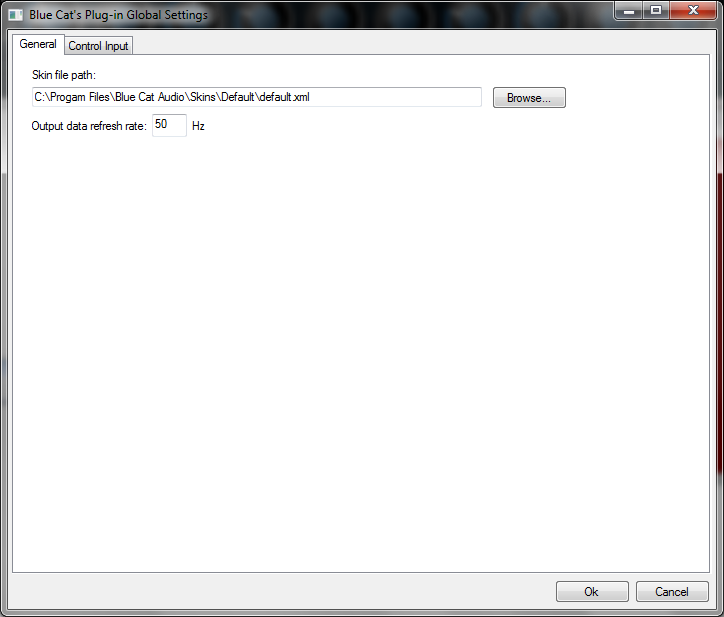
The output data refresh rate can also be customized for all instances of the plug-in. It controls the refresh rate of non-audio data produced by the plug-in (parameters, curves...). It also controls the refresh rate of output MIDI CC messages or output automation data. The higher the refresh rate, the better precision, but also the higher cpu usage (some host applications may also have trouble recording MIDI data at high refresh rates). The default value is 50 Hz.
Global Control Input Settings (MIDI and Automation)
The plug-in offers a couple of settings that affect the way it is controlled by MIDI messages or automation. While the first settings only apply to MIDI control, the "Control Response", "Min" and "Max" settings apply to both automation and MIDI control.
For each parameter you can define a default MIDI channel and CC number. You can then control the plug-in with an external MIDI controller or one of our plug-ins that generate MIDI messages.
The settings below are available for each plug-in parameter.
MIDI Settings:
- Enable MIDI: enable/disable the MIDI control of the parameter.
- Channel: MIDI Channel for the parameter control. If set to 0, the plug-ins will accept Control Change Messages from all MIDI Channels (MIDI Omni mode).
- CC: Control Change Number.
- Learn: click on this button to activate the MIDI learn functionality. When it is activated, you can move your MIDI controller, and the plug-in will automatically detect the control settings .
MIDI and automation settings:
- Response: response curve of the MIDI or automation control: from very fast to slow control.
- Min: minimal value of the parameter when MIDI controlled or automated.
- Max: Maximum value of the parameter when MIDI controlled or automated.
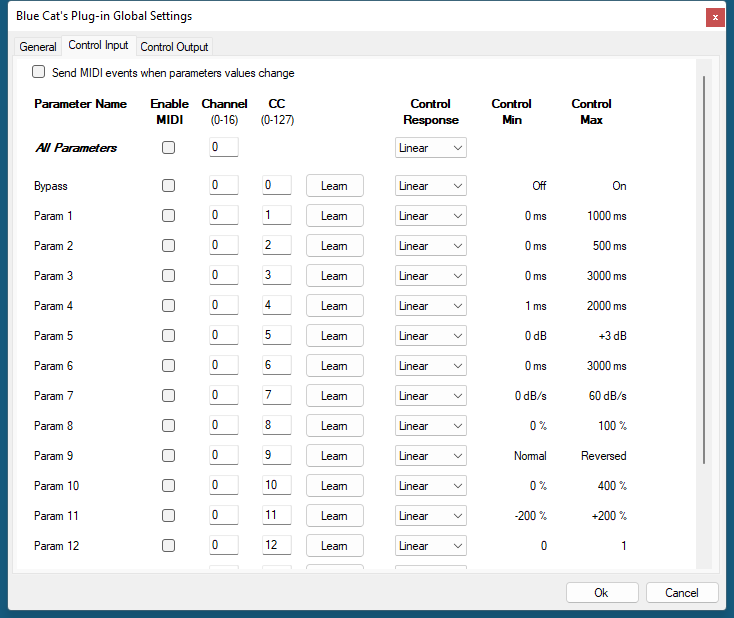
Note: if the Min value is higher than the Max value, the response curve will be reversed: increasing the control value will decrease the parameter value.
Note: if you double click on the parameter text control boxes for the max and min values, a “fine tuning” edit box will appear and let you change the min and max values with more precision:

"Send MIDI events when parameters values change": activate this option when using a control surface that accepts MIDI events as input. MIDI messages will be sent to the output of the plug-in when the user change the parameters values in the user interface, to keep the software and the controller in sync. MIDI is only sent for parameters that are activated for MIDI control.
The Current Preset Settings Window
In this window you can change the settings for the current preset of the current instance of the plug-in only.
Preset Skin
You can choose to use the global skin setting or to change the skin for the current preset. This way you can have different skins for different instances of the plug-in in the same session in order to differentiate them.
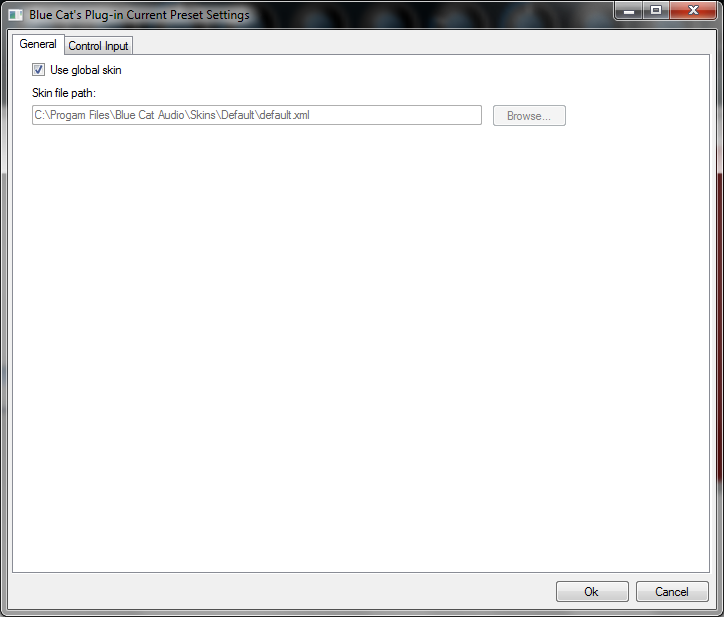
Preset Control Input Settings (MIDI and Automation)
Use the global settings or override them for the current preset. The parameters are the same as for the global input settings.
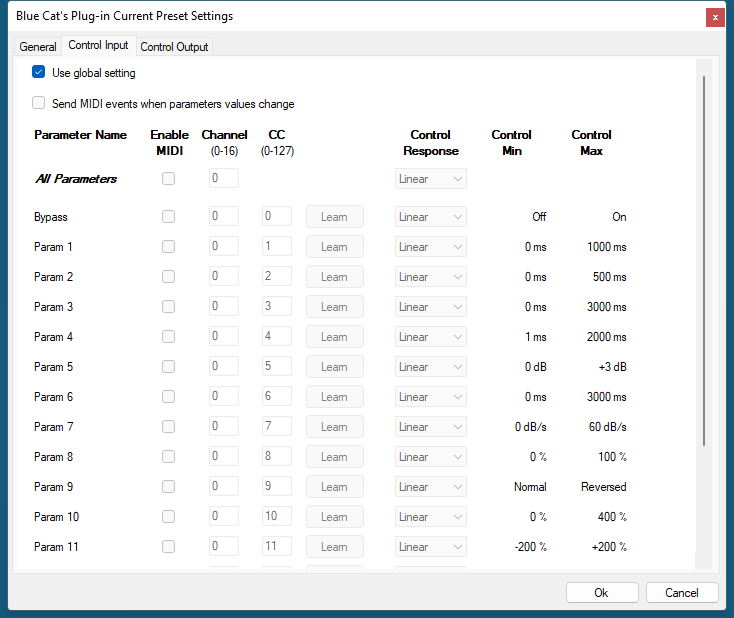
About Skins
Blue Cat's Late Replies integrates Blue Cat's skinning engine that allows you to customize the user interface. You can download alternate skins for your plug-in at the following address:
If you don't find a skin that fits your need or if you want a custom one, you can choose to create your own skin.
Choosing the Skin
There are two ways to select the skin of your plug-in: you can change the default (or 'global') skin, or change the skin for the current preset only (either in the preset settings page or from the main menu). The global skin applies to all plug-in instances (choose this one if you want to use the skin used by default, regardless of the session or preset), whereas the current preset skin only applies to the current preset of the current plug-in instance (use this one if you want to change only the skin for the current session/preset).
Note: in some host applications, the plug-in window won't resize automatically when you choose a skin with a different size. In this case, just close the window and re-open it: it will be displayed with the right size.
The Skins Menu
The skins menu can be opened from the main menu. It displays the list of skins available for the plug-in as well as commands to manage the skin used by default when no preset skin has been selected:
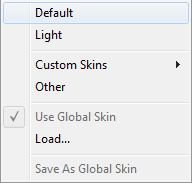
- First Section - Factory Skins: shows the list of factory skins delivered with the plug-in ("Default" and "Light" in this example).
- Second Section - User Skins: shows the list of user skins that have been installed in the Documents Skins folder for the plug-in (see below).
- Use Global Skin: use the global skin for the current preset/session (unloads any custom skin previously selected for the current preset).
- Load: opens a file browser dialog to manually select the skin from the file system.
- Save As Global Skin: use the current preset skin as the global skin (loaded by default if no preset skin has been defined).
Installing User Skins
To select user skins directly from the skins menu, install them in the "Skins" directory available in the plug-in's documents folder:
[Your Documents Folder]/Blue Cat Audio/[Plugin Name]/Skins/
The skin engine will scan this folder for new skins (xml files) and display them in the menu. The skin files should be in the root skins folder or in a subdirectory inside this folder: subdirectories are not scanned recursively.
Other Methods to Select Skins
You can also select the skins in the settings panels available from the main menu:
The global skin (used by default if no preset skin has been selected) can be changed in the global settings pane. The current preset skin can be changed in the preset settings page .
Create a Custom Skin
You can create custom skins for your plug-in in order to adapt it to your exact needs. You can change its look and feel and make it completely integrated in your virtual studio!
Just read the Blue Cat's Skinning Language manual and download the samples for the tutorial on http://www.bluecataudio.com/Skins. You can get ready to create your own skins in a few minutes. You can then share your skins on our website.
More...
This manual only covers the main aspects of Blue Cat's Late Replies. Our website offers many additional resources for your Blue Cat's Late Replies plug-in. It is constantly updated, so keep an eye on it!
Updates
As you can see in the history log below, we care about constantly updating our products in order to give you the latest technology available. Please visit our website often to check if Blue Cat's Late Replies has been updated, or subscribe to our Newsletter to be informed of the latest news about our products.
Note: minor version updates are available from the same location as the original full version download (link received by email upon purchase). The demo version publicly available on our website will not let you register.
You can also follow us on twitter, facebook and instagram for almost real time updates notification, and subscribe to our YouTube channel to watch the latest videos about our software.
Versions History
V1.69 (2025/09/08) |
|
V1.68 (2025/08/12) |
|
V1.67 (2024/09/09) |
|
V1.66 (2024/03/20) |
|
V1.65 (2023/06/13) |
|
V1.61 (2022/12/12) |
|
V1.6 (2022/10/17) |
|
V1.52 (2022/03/28) |
|
V1.51 (2021/11/18) |
|
V1.5 (2021/05/25) |
New Features & Improvements:
|
V1.42 (2020/10/05) |
New Features & Improvements:
|
V1.41 (2020/01/06) |
New Features & Improvements:
|
V1.4 (2019/07/01) |
New features:
|
V1.31 (2018/12/06) |
|
V1.3 (2018/11/12) |
|
V1.21 (2018/06/07) |
|
V1.2 (2018/06/05) |
|
V1.1 (2018/04/05) |
|
V1.0 (2017/08/24) |
First release. |
Thanks again for choosing our software!

See you soon on www.bluecataudio.com!

